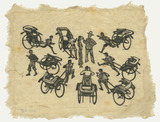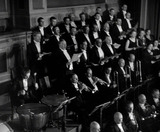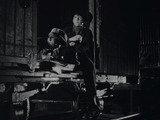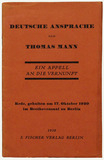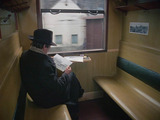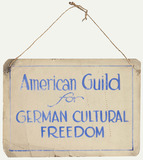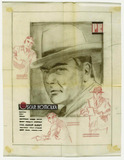David Ludwig Bloch: Zirkel von Rikschas, die zu einem Kunden eilen [Circle of Rickshaws Rushing to a Customer], woodcut (1941/1942)
Practically before the couple has had the chance to discuss the possibility of taking a rickshaw, the rickshaw coolies scramble to offer their services from all directions. The occasionally pushy efforts to win customers, the steps of the drivers that set the rhythm of the city, but also their everyday existence, became one of Bloch's favourite subjects in Shanghai.
Decision. A Review of Free Culture (1941-1942)
After emigrating to the USA, Klaus Mann intended to bring out a new magazine towards the end of 1939 which was to have a similar format as his other magazine Sammlung which was no longer being published. Following a planning phase of more than a year, January 1941 finally saw publication of the first issue of Decision with the sub-heading, Review of Free Culture.
Detlef Sierck, Final Accord (feature film, D 1936, film excerpt)
Final Accord was Detlef Sierck's first melodrama and pointed stylistically towards the great melodramas to come, for which he became famous in American exile. Originally from the theatre, Sierk saw his fourth film as a decisive milestone in his film work, because in it he tried out forms of expression using the visual image in a way that only the medium film can offer.
Detlef Sierck, Wilton's Zoo, (Spielfilm, NL 1939, Filmausschnitt)
Jan Grovers (Annie van Ees) along with his friend Pietje (Guus Brox) commit all kinds of scams in the streets of Rotterdam. A priest tries to take the boys from poor backgrounds under his wing and show them the right path.
Deutsche Ansprache. Appell an die Vernunft [An Appeal to Reason] (1930)
Writer Thomas Mann was actually invited by the Verband Deutscher Erzähler to read a few chapters from his new novel in Berlin in October 1930. But in light of the drastic gains by the NSDAP in the Reichstag election of September 1930, the newly-minted literature Nobel laureate decided to hold an additional event in Berlin's Beethovensaal.
Die versunkenen Welten des Roman Vishniac (Documentary film, Switzerland 1978, excerpt)
Documentary by Erwin Leiser about the photographer who chronicled Jewish historyRoman Vishniac, born in 1897 in Saint Petersburg, was a microbiologist, inventor, philosopher, university lecturer, art historian – and photographer. He already took his first photographs in 1906 showing the leg of a cockroach seen through a microscope.
Do you know where Mr. Kisch is? (documentary film, GDR 1985, excerpt)
About the writer and reporter Egon Erwin KischWriter and reporter Egon Erwin Kisch, who was born into a German-speaking Jewish family in Prague, was one of the most important reporters of the 20th century. Kisch reported in the 1920s from Asia, North Africa and the Soviet Union and published in 1925 his reports in the book The Raging Reporter whose title became a catchword for himself and his work.
Donation stamp for the five-year anniversary of the Free German League of Culture in Great Britain (c. 1944)
The Free German League of Culture in Great Britain issued donation stamps to mark its fifth anniversary. They were illustrated with portraits of figures who were associated with the League of Culture either in an organisational or more abstract way: the painter Oskar Kokoschka was one of the four presidents of the League of Culture and the most present in the public eye.
Doorplate of the American Guild for German Cultural Freedom
Office at Vesey Street 20, New YorkAn unassuming, hand-painted sign made of cardboard, affixed with nothing but a string, served as the official doorplate of the now famous organisation the American Guild for German Cultural Freedom. It's a testament to the austere conditions under which the organisation worked.
Draft advertisement for Oskar Homolka
Of the numerous émigré actors who were represented by agent Paul Kohner in Hollywood, Oskar Homolka was among the more successful ones.
